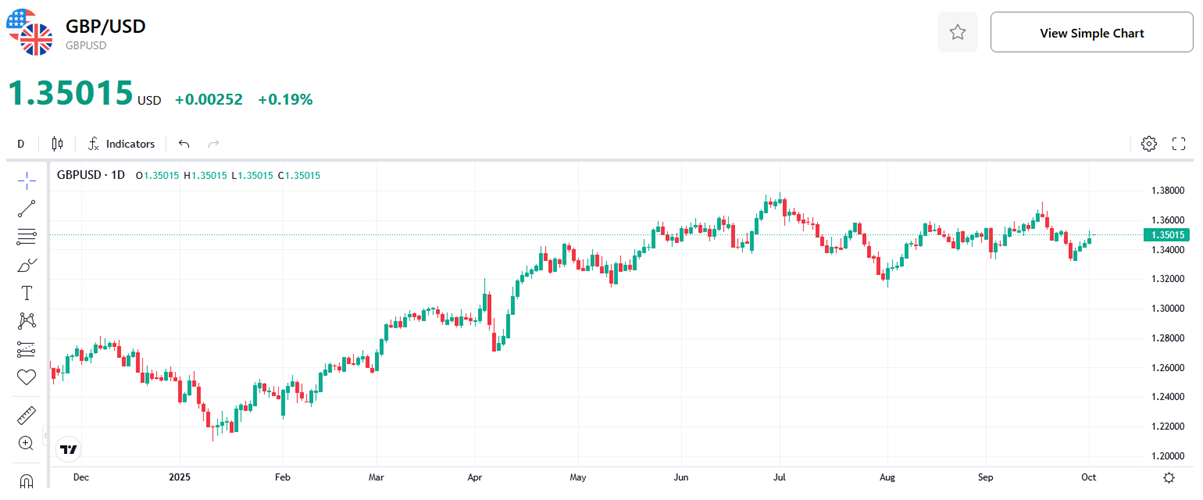Is the UK Economy Headed for Collapse? Will Assets Face a "Triple Slump" in Stocks, Exchange Rates, and Bonds?


1. Introduction
A slowing economy, persistent inflation, rising government debt, soaring bond yields, and the potential for fiscal austerity in the upcoming autumn budget paint a seemingly grim picture for the UK. Many investors and analysts assert that the UK economy is on the brink of collapse, with its assets facing a "triple slump" across stocks, foreign exchange, and bonds. However, we argue that this narrative is largely driven by a small group of alarmists amplified by a crowd of followers parroting sensationalist claims. Such predictions are overly pessimistic. This article aims to demonstrate that the UK is weakening, not collapsing. First, let’s examine the first of the so-called "triple slump": a plummeting pound?
2. First Slump: A Plummeting Pound?
Since mid-July this year, the British pound has exhibited range-bound fluctuation against the US dollar (Figure 2). This is primarily due to political uncertainty in the UK counteracting expectations of a renewed Federal Reserve rate-cutting cycle. Looking ahead, the pound’s trajectory will be shaped by three key forces:
First, the UK government, facing opposition from Labour Party politicians, has made concessions on the spending cuts proposed in the Welfare Reform Bill. The challenges in implementing this plan are likely to widen the fiscal deficit, with Chancellor Rachel Reeves estimating a budget shortfall of £20 billion to £40 billion. The absence of a clear strategy to address this gap creates uncertainty for investors, exerting downward pressure on the pound.
Second, ongoing political uncertainty in the UK, combined with a global economic slowdown, is expected to further dampen UK economic growth. This economic weakness will continue to weigh on the pound.
Third, persistent high inflation is likely to prompt the Bank of England (BoE) to slow its pace of interest rate cuts. In contrast, the Federal Reserve resumed its rate-cutting cycle on 17 September, with expectations of two additional 25-basis-point cuts this year. As the BoE's rate cuts lag behind the Fed’s, the interest rate differential between the US and the UK is expected to narrow or even reverse, providing support for the pound against the dollar.
In summary, we believe the first two forces will be largely offset by the third, resulting in the British pound maintaining its range-bound fluctuations against the US dollar, with a very low likelihood of a sharp decline. Having addressed the first point, let’s now examine the second: a UK stock market crash?
Figure 2: GBP/USD

Source: Refinitiv, TradingKey
3. Second Slump: A UK Stock Market Crash?
Recently, the FTSE 100 index reached an all-time high, and the future trajectory of UK stocks will be shaped by the interplay of opposing forces. On the negative side, a slowing economy coupled with persistent high inflation is showing early signs of stagflation in the UK. Although the current level of stagflation is mild, it still poses a headwind for the stock market. On the positive side, while high inflation has slowed the BoE’s pace of interest rate cuts, the broader trend toward monetary easing remains intact. Increased liquidity from this policy direction will provide support for the stock market.
Additionally, over 70% of the revenue for UK-listed companies comes from overseas, resulting in a high correlation between the UK stock market and global markets, particularly US stocks (Figure 3). Supported by preventive rate cuts, US stocks are expected to continue rising, with positive spillover effects likely to benefit UK stocks. Overall, the likelihood of a UK stock market crash in the short to medium term is negligible. Our baseline forecast is that UK stocks will continue to rise, though negative factors may limit their gains compared to US stocks.
It’s worth noting that, while we expect the FTSE 100 index to continue its upward trend, certain sectors and individual stocks may underperform the broader market or even experience short-term declines. In the Autumn Budget to be announced on 26 November, the Chancellor may introduce tax increases to address the fiscal deficit. Sectors such as banking, gambling, and real estate are likely to be significantly affected by these tax adjustments. Therefore, investors in UK stocks should avoid these sectors, including banking stocks like Lloyds Banking, HSBC, NatWest, and Barclays; gambling stocks such as Flutter Entertainment, Entain, and Rank Group; and real estate stocks like Land Securities, British Land, and Berkeley Group. Having analysed the second slump, let’s now turn to the third: a UK bond market collapse?
Figure 3: FTSE 100 vs. S&P 500
-d3f0bb3cbfe54088a633bcfbeeb325c1.png)
Source: Refinitiv, TradingKey
4. Third Slump: A UK Bond Market Collapse?
Due to a structural decline in demand for long-term gilts from pension funds, the yield on the UK's 30-year government bond has surged significantly recently, leading to a rapid steepening of the yield curve. However, looking ahead, the probability of long-term gilt yields continuing to rise sharply is very low, for two main reasons: First, the BoE has reduced the scale of its quantitative tightening program from £100 billion to £70 billion. Second, the UK Debt Management Office has implemented a strategy to "shorten the duration of bond issuance," lowering the proportion of long-term gilts in total issuance from nearly 20% last year to around 10%. Both measures will reduce the market supply of long-term gilts, driving up their prices and thereby suppressing yields.
Regarding short-term gilts, although the BoE has slowed its rate-cutting pace due to persistent high inflation, the rate-cutting cycle has not yet ended. As a result, short-term gilt yields are expected to decline gradually and modestly. Overall, the "short-end down, long-end up" trend observed in the yield curve over the past year (Figure 4) is unlikely to continue. Looking ahead, the entire yield curve is expected to shift slightly downward. In other words, the likelihood of a UK bond market collapse triggered by a significant upward shift in the yield curve is extremely low.
In conclusion, our assessment that the risk of a "triple slump" across stocks, forex, and bonds is minimal is grounded in a thorough analysis of the broader economy. Next, we will examine the UK’s macroeconomic conditions in detail.
Figure 4: UK Gilt Yield Curve (%)
-9d3b51e3f7854b71ae5a6b43f7f9c88e.png)
Source: Refinitiv, TradingKey
5. Macroeconomic Outlook
5.1 Pessimists’ Focus: UK Government Debt
Many investors and analysts bearish on the UK economy frequently highlight one issue: the recent surge in UK gilt yields. On the surface, this spike appears driven by a sharp decline in demand. However, the deeper issue stems from the UK’s persistently high debt levels, compounded by the government’s challenge in curbing expenditure. For instance, spending on healthcare and pensions, which constitute a significant portion of the budget, is largely non-discretionary. Additionally, Personal Independence Payments (PIP) have seen substantial year-on-year increases due to an expanding definition of disability and an ageing population. Similarly, winter fuel payments remain difficult to scale back.
These factors have driven a significant increase in the UK government's net and gross debt, rising from £1.57 trillion and £1.75 trillion in 2016 to approximately £2.8 trillion and £3 trillion today, respectively. Over the past decade, both metrics have surged by more than 75% (Figure 5.1.1). The high level of government debt has raised market concerns about repayment capacity, directly pushing the 30-year gilt yield to 5.69% on 2 September, marking its highest level since 1998 (Figure 5.1.2). While we acknowledge that the government’s mounting debt has profound implications for the UK economy, it’s important to recognise that the economy is not entirely without strengths.
Figure 5.1.1: UK General Government Debt (Billion Pounds)
-5c240dc8af184f18a4ec171c0dc5a4a1.png)
Source: Refinitiv, TradingKey
Figure 5.1.2: UK 30-Year Gilt Yield (%)
-0a97e636d57d41c989274bb7e0b0495c.png)
Source: Refinitiv, TradingKey
5.2 Economic Growth
In the first half of this year, the UK economy demonstrated relatively robust growth. Real GDP grew by 0.7% quarter-on-quarter in Q1 and 0.3% in Q2, driving year-on-year growth rates of 1.7% and 1.4%, respectively (Figure 5.2). Despite challenges such as concerns over government debt, a sluggish labour market, and potential fiscal austerity measures in the upcoming Autumn Budget, high-frequency data show no signs of a sharp decline.
On the demand side, UK retail sales, after experiencing negative growth in May, showed a clear recovery from June to August, with an average year-on-year growth rate of 0.8% over these three months. On the supply side, while manufacturing PMI data remain subdued, the services PMI, which accounts for a larger share of the UK economy, is in expansion territory at 51.9. In summary, we expect UK economic growth to continue slowing, but claims of a "collapse" are entirely unfounded.
Figure 5.2: UK Real GDP (%)
-36de6af5f3874381b6c8d2ede36b52de.png)
Source: Refinitiv, TradingKey
5.3 Inflation
Since the UK headline CPI fell to a low of 1.7% in September last year, it has been steadily rising. By August this year, headline CPI reached 3.8%. Meanwhile, over the past year, core CPI has consistently remained above 3%. This indicates that both headline and core inflation are significantly above the BoE’s 2% target (Figure 5.3).
Looking ahead, we expect UK inflation to gradually decline for two main reasons. First, the factors driving the recent rise in headline inflation are largely temporary, such as increases in water and electricity bills and employers passing on higher tax costs to consumers. As energy prices stabilise, inflationary pressures are expected to ease over the coming quarters. Second, the slowing UK economic growth will curb inflation from the demand side. In summary, while the UK economy is exhibiting signs of stagflation, with growth slowing but not contracting and high inflation expected to moderate, we assess that the degree of stagflation will remain mild.
Figure 5.3: UK CPI (%, y-o-y)
-ffeff8ef05b44a389e8b97d136c2f4bc.png)
Source: Refinitiv, TradingKey
5.4 Monetary Policy
To address the slowing economic growth, the BoE initiated a rate-cutting cycle in August last year. So far, it has reduced the base rate from 5.25% to 4%, a cumulative cut of 125 basis points (Figure 5.4). Looking ahead, given that both headline and core inflation remain well above the target in the short term, the BoE is likely to pause its easing cycle in the coming months. However, from a medium-term perspective, as inflation moderates and economic growth continues to slow, the overall direction of monetary easing is expected to persist. We project that the BoE’s base rate will fall to 3% by the end of 2026 or early 2027.
Figure 5.4: BoE Policy Rate (%)
-4ccf81a35f3b4747a565cbb5add2c253.png)
Source: Refinitiv, TradingKey
6. Conclusion
All in all, we acknowledge that the UK economy faces long-term structural challenges. However, concluding that the economy is on the verge of collapse and that its assets will crash based solely on selective negative news and short-term market fluctuations is, in our view, overly alarmist. Based on the analysis above, our baseline assessment is as follows: the UK economy is experiencing mild stagflation, the pound will continue to fluctuate within a range against the US dollar, UK stocks are likely to see modest gains, and the gilt yield curve is expected to shift slightly downward. As for the pessimists’ predictions of an economic collapse and a "triple slump" across stocks, forex, and bonds, we believe the likelihood of such an outcome is extremely low.







